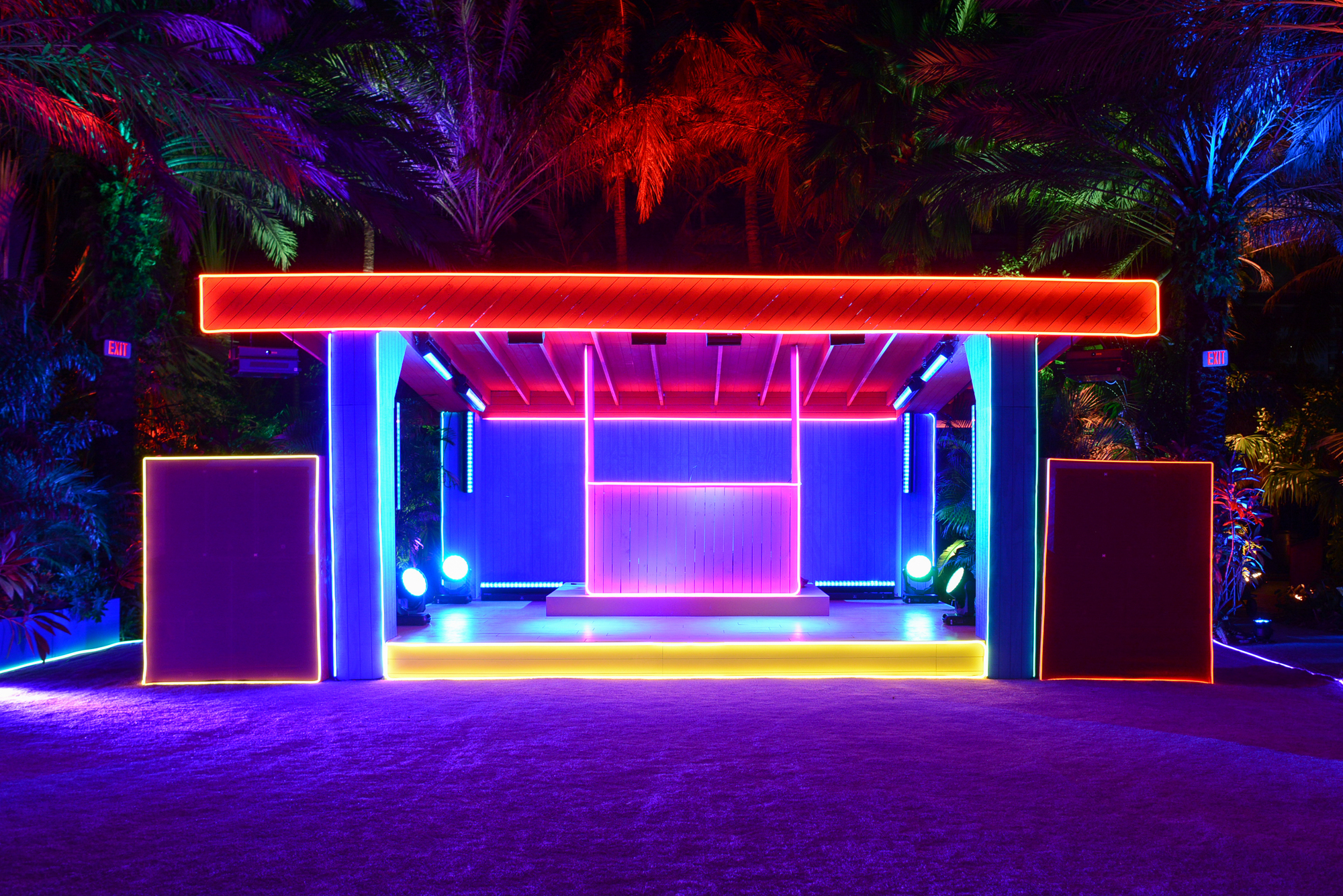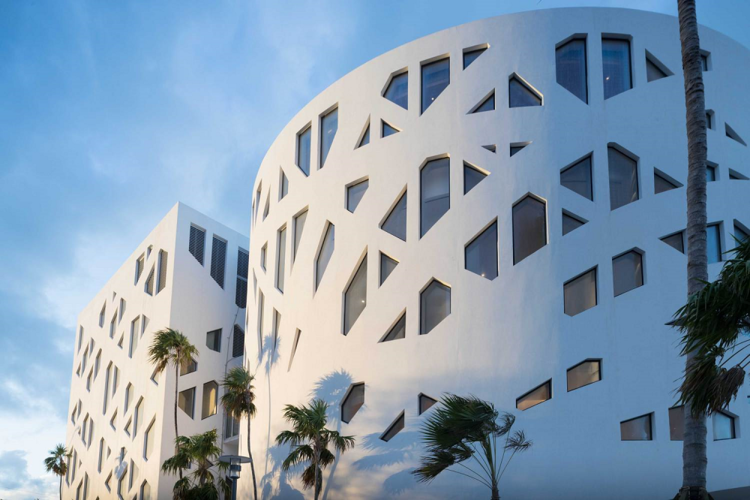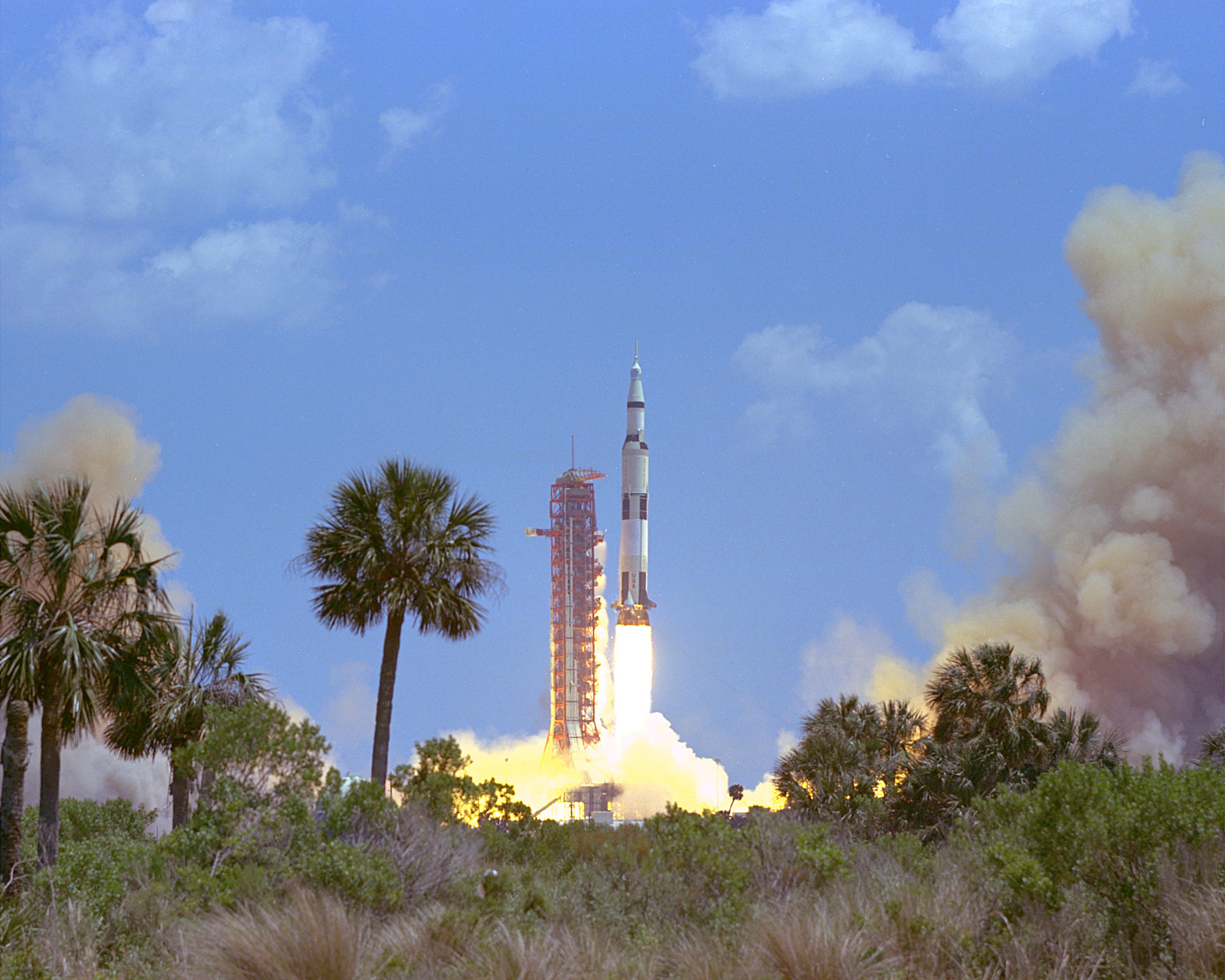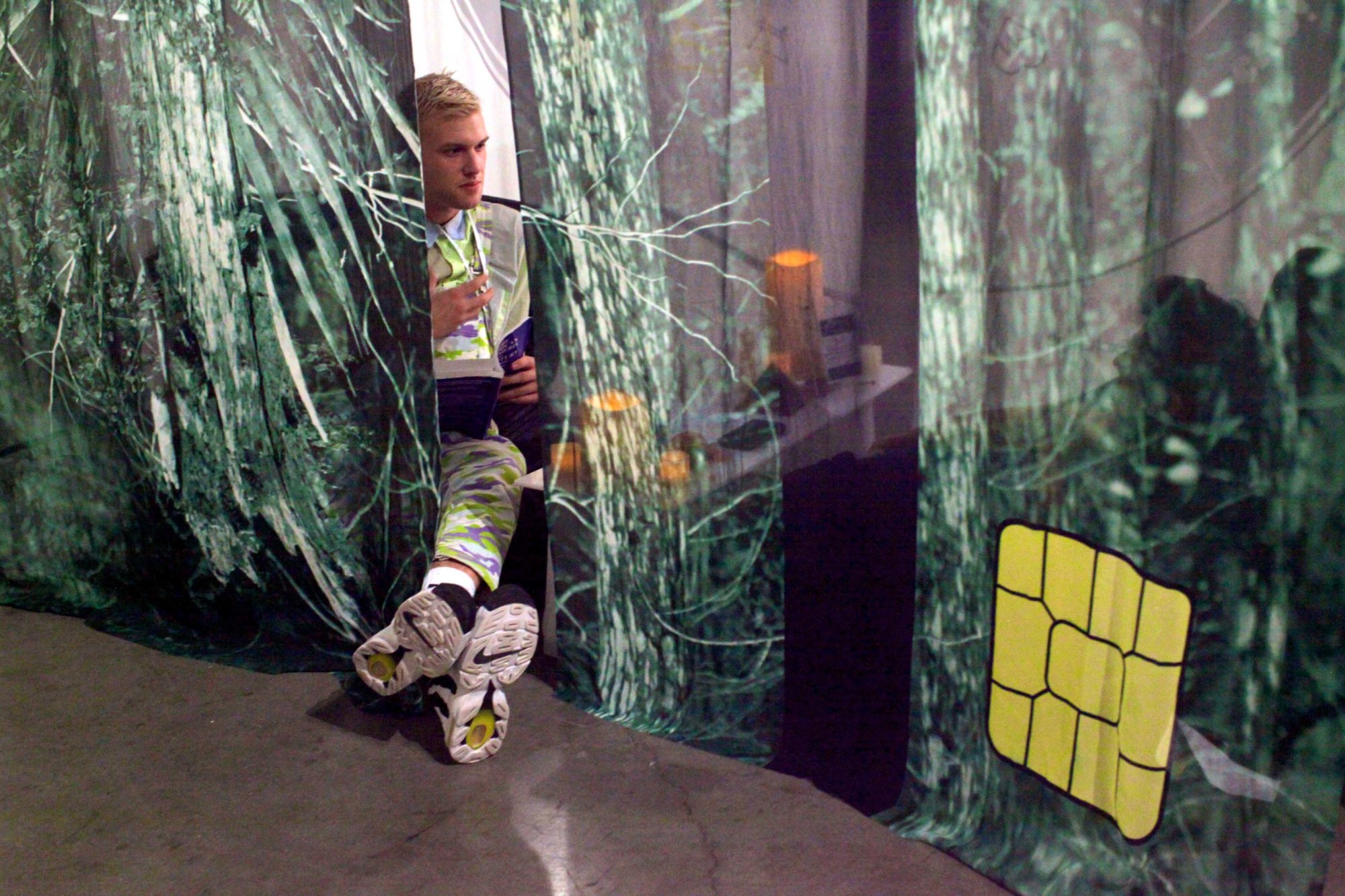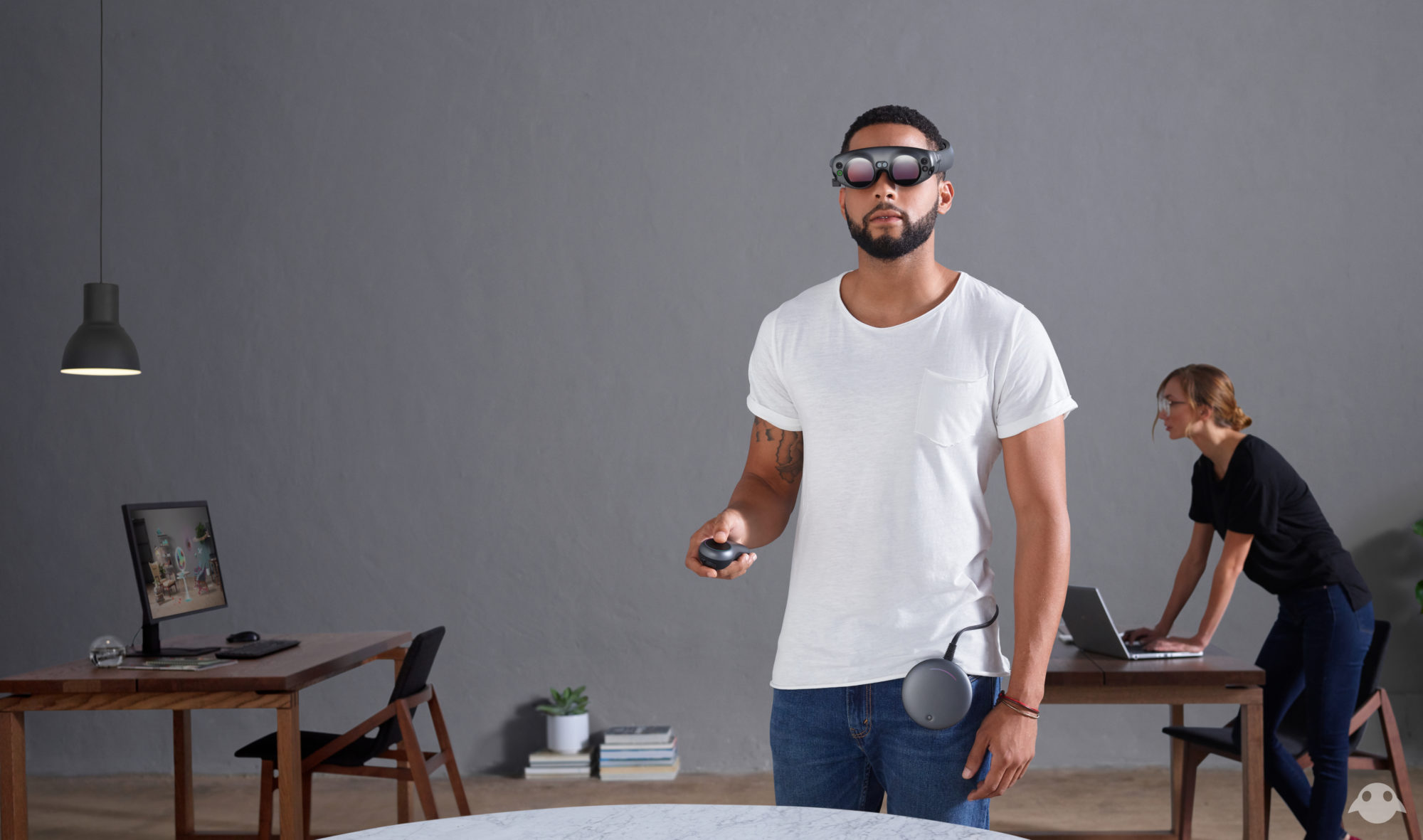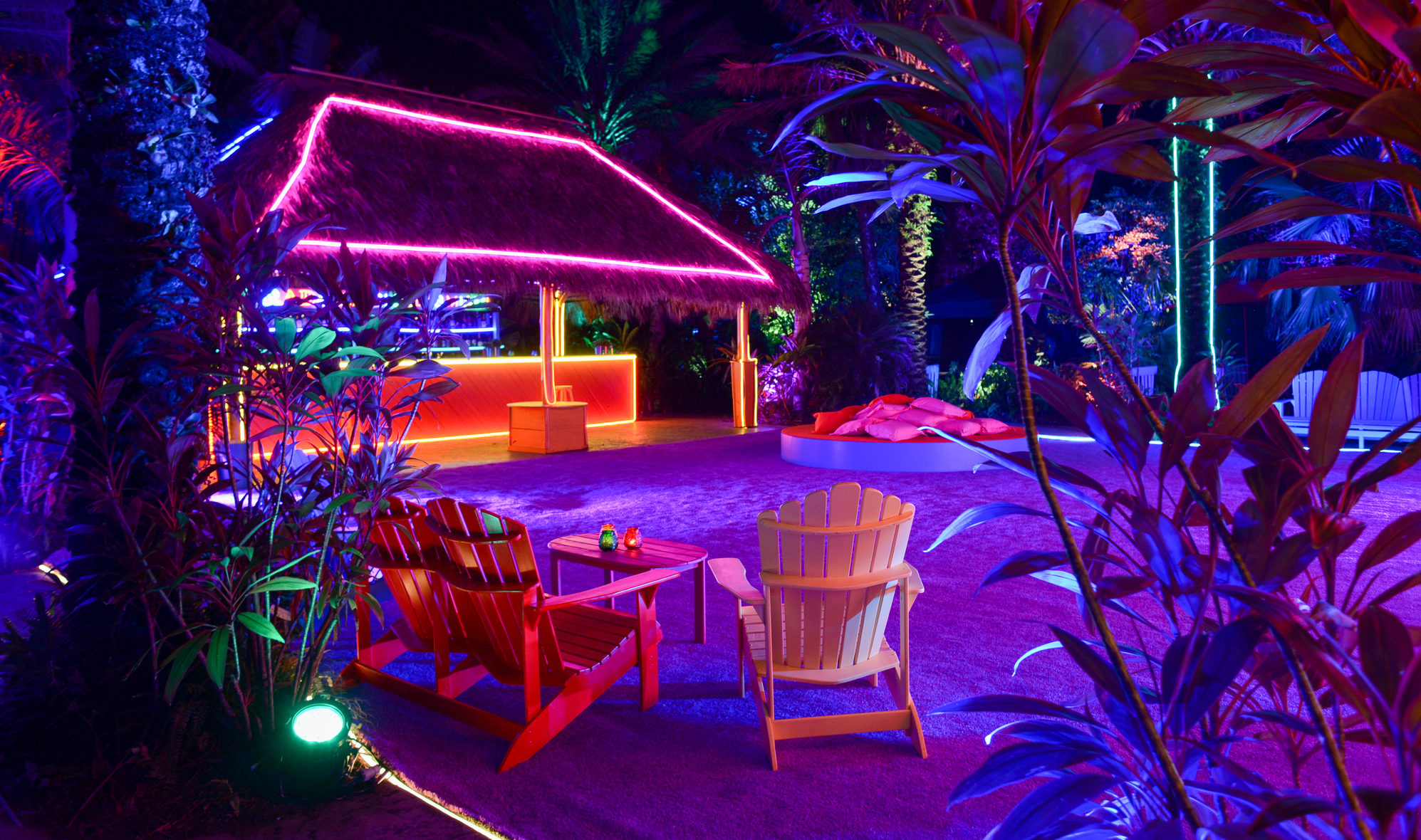
The Prada Double Club Miami, designed by artist Carsten Höller for the Fondazione Prada, Art Basel Miami Beach (December 5-7, 2017) [Photo: Casey Kelbaugh; courtesy of the Fondazione Prada]
Tropical Hangover
“Tip the world on its side and everything loose will land in Los Angeles,” goes the apocryphal Frank Lloyd Wright quip on California’s sprawling metropolis. He could just as easily have been talking about Florida.
Share:
Long ridiculed as the cultural dumpster of America, Florida has emerged within recent years as a staple of global culture—perhaps because of its resistance to a single typology rather than in spite of it. Nobody quite knows what to make of the swampy peninsula, which in addition to being synonymous with global orange juice supply and bragging rights to a Disney World Resort roughly the size of San Francisco quietly boasts an array of unexpected titles: Florida is an unlikely outpost of North American Amish and Mennonite communities and the birthplace of the rollerblade- accessible ATM (built by Citibank to accommodate Miami Beach’s in-line skaters). Its Atlantic-facing “Space Coast” is home to the post-NASA privatized Space Race 2.0 led by big fish including Jeff Bezos and Elon Musk, to venture capitalist-backed tech startups including the augmented reality (AR) company Magic Leap (currently valued at $6 billion), and, since 2001, such tax-friendly perennial art parties as Art Basel Miami Beach.
What claims did Florida stake with its post-global cultural capital? Despite its gains in art world cool and Silicon Valley opportunism, the Sunshine State seems to be operating, as it always has, in a state of alternative reality that is forever on the verge of being proven a dream. It maintains a total indifference to its own cinematic appearance: a sun-drained, pastel-hued, low-key kaleidoscopic aesthetic that directors such as Harmony Korine and Sean Baker have sought to capture, product of constant heat and seasonless dilations of time, and manifest in the motel-based brothels stationed on the fringes of Disney World and in the neon-soaked violence cloaked by seemingly harmless spring break charm. The mythology of the Sunshine State is that of a place where sublime happiness and unspeakable horror can somehow coalesce in the darker side of paradise, where sites such as Gianni Versace’s Miami Beach mansion or Orlando’s Pulse nightclub can turn from Elysium to abbatoir in the blink of an eye. Even the dream of its moneyed or conservative hetero-utopias— the Florida of retirees, tech bros, regional day-trippers, and art world elite semi-begrudgingly descended from Europe and New York for an early winter escape—often resembles a nightmare. The state is known for a flippant political temperament: going Blue in 2012, Florida played a crucial role in Obama’s re-election; four years later, it was a swing state that levied Trump’s election. Everyone, it seems, wants a piece of Florida, but nobody (not even Floridians) can agree on what Florida really is. And Florida’s constantly changing geography, in which rising tides are estimated to gradually engulf circa 12.5% of Florida’s homes by 2100, is perhaps an appropriate metaphor for the state’s schizophrenic personality, which likewise isn’t going away anytime soon.
The Prada Double Club Miami, designed by artist Carsten Höller for the Fondazione Prada, Art Basel Miami Beach (December 5-7, 2017) [Photo: Casey Kelbaugh; courtesy of the Fondazione Prada]
SWAMP MYTHOLOGIES
The Florida mystique can be traced back to a fantasy of the Fountain of Youth—a widespread legend that in its regional iteration originated by the Caribbean Taíno but widely associated with the 16th-century Spanish Explorer Juan Ponce de León who encountered them1. A spring was said to exist on the island of Bimini, and lead to a river in what is now Florida that would grant eternal youth to bathers. Before Columbus’ arrival, many Taíno from Cuba were said to have traveled to the area in pursuit of this mythic river. Following the Spanish colonization of Florida in 1513, the legend was passed to the nation of Calusa, Florida’s largest indigenous tribe and the main opposition to the conquistadors. Fueling the flames of this ecstatic fantasy, burnt into Spanish desire, the legend sent the starry-eyed Spaniards farther into the perilous depths of Florida’s alligator-riddled swampland.
By the late 1800s—following two periods of Spanish rule, 20 years of British sovereignty, a brief period of independence in the early 19th century, and nearly a half century as a US state—the state had developed its own reputation as a sort of inhospitable southern Wild West, according to Gary R. Mormino in his history of modern Florida2). Spurred on by an ethos of individualism, the right to bear arms, and a weak state government that came out of the frontier movement, Florida’s speculative personality kicked into high gear in the 1920s, when it was a particularly hot regional market in the nationwide real estate bubble that heralded the (far more famous) stock market crash at the end of the decade. Florida has maintained its status as a real estate trailblazer ever since, buoying itself back from the 2007–2010 subprime mortgage crisis through a combination of easy credit opportunities and seductive branding promising a new life of sunshine and leisure.
The drainage of Florida’s Everglades was a national talking point in US politics at the turn of the 20th century. Until the 1890s, almost all of the state’s population lived within 40 miles of the Georgia border; draining the swamp opened up large areas of previously unbuildable (and unsellable) acreage to development. The state unveiled its new land to journalists in 1912; the excellent publicity helped developers sell 20,000 parcels within months3. Local accounts from the mid-1920s discuss a “collective madness” that came over Florida investors at the time. Empty lots in the newly planned communities of Miami and Palm Beach were bought and sold as much as 10 times in a single day. Both private buyers and commercial developers could buy land in Florida without ever setting foot in the state, thanks to hirable intermediaries. It was a feverish moment in Sunshine State history, when the speculative economy produced tycoons with astonishing power. Publicity-savvy entrepreneurs such as Carl Fisher in Miami Beach and George Merrick in Coral Gables were pivotal to the area’s transformation into a modern-day metropolis, and they did so as much by trading on speculation—and image—as they did with actual investment in building and infrastructure. (These developers not only made sure Miami was fully accessible by rail and highway, for example, but also made sure they were properly promoted: Merrick aligned his Coral Gables with the “City Beautiful” movement; Fisher famously purchased an illuminated sign in Times Square that read, “It’s June in Miami.”) 4
When the bubble burst, Florida certainly wasn’t alone—the entire country experienced economic hardship in the 1930s—but the state bounced back in the lead-up to WWII, its year-round sunshine providing ideal conditions for military training. Florida’s population grew by almost 50% in the 1940s; following the war, many naval, air force, and army facilities remained. Having temporarily converted hotels, resorts, and other tourist destinations into military facilities, the state was left with the knowledge and resources it needed to attract federal jobs and infrastructure—and the promise to sustain them.
Faena Forum, designed by Rem Koolhaas/OMA, 2016 [photo: Nikolas Koenig; courtesy of Faena Art]
FAENA ART (Buenos Aires/Miami Beach) describes itself as “a nonprofit organization that houses and produces post-disciplinary and time-based experiences,” “[a] catalyst for innovative, site-specific, and immersive creative practices,” and “a transformative bridge across the Americas, between the south and the north, the popular and the experimental.” Founded by Argentinian hotelier Alan Faena, artistic directed by Ximena Caminos, and guided by an international advisory committee called the Faena Circle, Faena Art has two locations: Faena Art Center in Buenos Aires and Faena Forum, a monumental Rem Koolhaas/OMA design facility in Miami Beach (opened in 2016).
STATE(S) OF EXCEPTION: RODENTS, ROCKET SHIPS, AND ROADSIDE PAINTERS IN POST-WAR FLORIDA
In the 50s Walt Disney went in search of a location for his “Project X”—later known as the “Florida Project,” after the Orlando area beat out a number of other national contenders (St. Louis, MO, among others). In order to acquire the more than 27,000 acres of land necessary to build his soon-to-be “world” without disclosing his identity, Disney set up countless fake corporations that let him make purchases in less conspicuous chunks—a secret plan that the Miami Herald famously busted in May 1965. Today we might have spotted the ruse more quickly: Disney used absurd names for his fictional companies, including the dad joke end all dad jokes—M.T. Land—in his acquisition of swamplands outside Orlando.5
Adjacent to the Florida Turnpike, which connects central Florida to Miami, was Disney’s main incentive: the emergent Interstate 4, which would soon connect the amusement park to I-95, and thus to the entire East Coast. (According to Florida historian Richard Foglesong, when Disney was later asked why he chose Orlando, his stoic response was: “The way the roads crossed.”6).) All that was required were some 6 million tons of packed dirt to convert the cheap, reptile-filled swampland into buildable real estate. When the Miami Herald published its Disney scoop, the fantastic elasticity of Florida’s real estate market glimmered: practically overnight, the price of the desired land skyrocketed from $80 per acre to $80,000 per acre. Relatively speaking, Disney paid a fortune for the last pieces of land required to execute his vision. 7
Meanwhile, just east of the developing Disney World, an entire economy was unfolding around the development of actual rockets on Florida’s Atlantic Coast. In December 1959, the Department of Defense transferred 5,000 personnel to the area, moving its Missile Firing Laboratory to NASA. In 1961 President Kennedy made his famous commitment to “achieving the goal, before this decade is out, of landing a man on the moon and returning him safely to the earth.” A year later NASA acquired more than 200 square miles of land on and around Merritt Island, where it would base its Launch Operations Center (renamed the John F. Kennedy Space Center (KSC) after the president’s assassination in 1963). Because of its proximity to the equator and location on the Intracoastal Waterway, the KSC became the primary spaceport of the US, hosting all federal manned spaceflights beginning in the late 1960s.
Apollo 16 Launch, 1972, image #72PC-0177 [courtesy of NASA and The Commons]
Back on Earth, the lack of state personal income tax and agreeable weather made Florida the prime destination for the Northeast’s “snowbird” retirees, as well as an international attraction for British and Canadian immigrants. In 1950, with 2.81 million residents, Florida ranked 20th among the states in population; in 2018 it has swelled by more than 650% to be ranked third, beating New York with close to 21 million residents in total.8[1] Thanks to baby boomers’ growing wealth and ambition, many new businesses came to Florida in the 1960s; meanwhile, the state’s speculative economy provided a unique enclave not only for new trade in general but also for pockets of economic prosperity for minority populations in the Jim Crow south.
One result of this relative access was the emergence of alternative visual cultures. And one group to channel the state’s entrepreneurial advantage into artistic production was the Highwaymen, an informal collective of about two dozen self-taught black painters who collectively produced close to a quarter million paintings of Florida’s unique landscape from the 1950 to the 1970s. In an era when businesses, parks, and even residential suburbs were segregated, the Highwaymen tapped into a growing market for Florida-themed art, selling their work straight from their car trunks to tourists up and down the Gulf Coast. Their activities occurred along US 1, which bisects Disney World and the Kennedy Space Center—as well as the trajectories of souvenir-hungry vacationers, and the (predominantly white) new small business owners seeking cheap and cheerful decorations for the beauty salons and motels that would cater to them. “I would drop off my painting at a bank or motel and the owner would say, ‘come back in 3 weeks and I’ll pay you,’” recalls Roy McLendon, an original member of the Highwaymen group. “They always did settle up.” McLendon says he never encountered any aggression directed toward him while selling his work there along US 1, but that may be mostly because of the Highwaymen’s own strategic choices. “I knew my clients’ areas around Fort Pierce,” recalls McLendon, “and I’d never go beyond them. There were certain parts of town you knew to avoid.” The Highwaymen’s landscapes, however, have gone well beyond the painters’ original beat: the works are now highly sought-after, and their Floridian aesthetic of leisure, freedom, and a little mystery infuses the collections of such luminaries as Steven Spielberg and the Obamas.
Alfred Hair, Peach Cloud Morning, undated, collection of Roger Lightle [courtesy of A.E. Backus Museum]
THE ART PARTY: VIOLENCE IN THE VR JUNGLE
When, in the 1990s, Swiss contemporary art giant Art Basel began looking for a second location that would expand its influence in the US, Miami—with its tropical winter climate, low taxes, cultural diversity, and resort vibes—emerged as a clear choice. After considerable effort spent convincing the city that an art fair would be profitable, the first edition of Art Basel Miami Beach (ABMB) was finally confirmed to take place at the Miami Beach Convention Center December 12–16, 2001. In the aftermath of 9/11 and the subsequent anthrax scares, the inaugural fair was canceled, leading local art patrons including collectors Carlos and Rosa de la Cruz and Don and Mera Rubell to improvise events, opening their homes to showcase recent acquisitions; these once-intimate (for a certain elite) gatherings would become annual traditions even once the fair made its debut the following year. In the 15 years since, the fair has grown astronomically; its parties are frequented, hosted, and headlined by celebrities from every “list” (A through D), resulting in a week of citywide, invitation-only revelry.
Each year criticisms that ABMB has become more about parties than art multiply, and every iteration seems to have its own particular dramatic focus: recently, an on-site stabbing (2015), a Zika scare (2016), and a spate of sexual harassment scandal (2017). Still, the event continues to attract a large international crowd of collectors eager and able to drop millions on art by day, and after-party hop by night. In an “Art Basel Miami: An Oral History,” published in the luxury magazine Departures in 2014, the fair’s founding director Sam Keller recounts an anecdote from 2006:
“One gallery told me, someone came in, in flip-flops, with children from the beach and asked about the Picasso [on their stand], a picture worth several million dollars. The next day, the woman came back and said, “If you can deliver it by January 17, I’ll buy it.” It sold. 9
The fair continues to straddle the fine lines between commerce and celebration, high art and pop culture. (Celebrities don’t just attend events and purchase art in Miami, they also exhibit it there—e.g., Miley Cyrus’ debut solo show, Dirty Hippie, at the Raleigh Hotel in 2014.) Whatever spectacle seizes the tropical art oasis from year to year, the power players all benefit: dealers and buyers get tax breaks; big-ticket artists such as Damien Hirst and Carsten Höller are given the opportunity to combine forces with major sponsors—in Hirst and Höller’s cases, BMW and the Fondazione Prada, respectively—for big-budget, dazzle-driven commissions that boost everyone’s cultural capital (or at least, everyone who managed to get in to the launch). Media outlets have their pick of click-bait–worthy headlines to choose from for their write-ups, and even the highbrow critical journals relish making fun of the decadence while fully indulging in every event’s offerings.
It is fitting that the fair’s most infamous moment of drama—the 2015 stabbing—occurred near The Swamp of Sagittarius, a virtual reality (VR) installation created by Miami artist Naomi Fisher in collaboration with Agatha Wara that explores themes of cosmology, astrology, and destiny. As evidence that ABMB’s perceived aura has perhaps eclipsed its reality, and the distinction between sincerity and parody has become blurred beyond recognition, this moment proved to be a watershed: a real stabbing that was easily mistaken as a performative artwork commenting on the fair’s excesses. This instance of violence was as surreal as it was seemingly inevitable—“written in the stars,” as some might say, or perhaps latent in the mire.
Naomi Fisher and Agatha Wara, “Swamp of Sagittarius,” 2015, performance view of a reading by Morgan Rehbock at Art Basel Miami Beach [courtesy of Naomi Fisher Studios]
Star signs aside, VR’s participatory and spectacular aspects give the medium great chemistry with the general atmosphere of Miami during art week. In 2016 the online sales platform Artsy teamed with the music streaming service SoundCloud for Collective Reality, an “immersive, sensory art experience” supported by Italian fashion giant Gucci. The “headset-free” VR installation launched at the Faena Art “Time Capsule”—a trippy geodesic dome on the beach—just weeks after the sleek OMA-designed Faena Forum was unveiled to the public. The project involved a 360-degree projection produced by Rachel Rossin, with a soundtrack by Atlanta’s alt-R&B singer/producer/songwriter ABRA. Excerpts of Collective Reality were made available on Artsy’s Facebook page—not quite everyone’s collective experience, perhaps, but certainly an ambitious integration of art, music, and fashion, galvanized by VR technology (and no shortage of PR).
During ABMB 2015, a VR installation had already been featured at the Miami Beach location of the multinational co-working space WeWork; titled Light Spirit, the project was a co-creation of the Los Angeles VR company New Tropics and FriendsWithYou, a creative duo known for its surreal, bright, amorphous figures, designs, and installations. Using a state-of-the-art headset and new laser technology called HTC Vive, Light Spirit enabled Miami users to physically interact with an animated creature—sort of an ambient, psychedelic cartoon—in an artificial environment. The VR highlight of Miami Art Week 2017 was an installation critics love to hate: an augmented-reality trip to Las Vegas hosted by the now permanently closed Zadok Art Gallery. Part of the Vegas: Alter Your Reality (VAYR) marketing program initiated by the Las Vegas Convention and Visitors Authority, the “multi-sensory event” (powered by Samsung Gear VR) included artist Mike Winkelmann’s three-minute run through a utopian, neon-drenched imaginary Strip, complete with holographic buildings and flying cars promising a 1980s dream for the near future, a dream of the 80s superimposed onto the near future. Winkelmann was one of five artists whose promotional material for Las Vegas was exhibited during ABMB—among many nonart-world ancillary exhibitions and special events that have popped up around the fair in hopes of seducing some of its cultural capital-rich audience. (Vegas, it should be noted, was a close second in the race for Art Basel’s US location.) Like the (perhaps misnamed) Collective Reality, Vegas: Alter Your Reality is a fait accompli of the medium’s ability to fold together art, technology, participation, and commerce within and beyond the context of the art fair.
Magic Leap promotional image [courtesy of Magic Leap]
SILICON SWAMP: MAGIC LEAP AND THE LOW-KEY TECH TAKEOVER
Florida serves as an incubator for VR well apart from Art Week capitalism. Based within a nondescript suburban office block on the outskirts of Fort Lauderdale, Magic Leap is the unlikely rival of tech industry mainstays—including Facebook, Apple, and Amazon—in the (animatronic) arms race toward artificial reality. Created in 2010, Magic Leap began promoting their first product to the public in 2015 and has since secured an estimated $2.3 billion of financial support from venture capitalists and other investors including Steven Spielberg, Lucasfilm’s and Industrial Light & Magic’s ILMxLAB, and most recently Saudi Arabia’s Public Investment Fund in March 2018—to the tune of $400 million. The company’s founder, Rony Abrovitz, is an unassuming, rosy-cheeked optimist who loves dogs and Disney and whose demeanor is a far cry from the tech world “blue steel” veneer of a Jobs or a Bezos. Abrovitz is certainly no stranger to the investment game, having sold a health start-up for $1.65 billion before founding Magic Leap. His relative naiveté within the VR scene distinguishes him from the Silicon Valley demigods, as does his harnessing of that Magical Kingdom sense of wonder toward technology that’s endemic to Florida. “I’m always learning more about how the brain works,” he gushed in an interview with Wired back in 2016.10 “Magic Leap is just the training wheels that will start to unlock all that potential.” In an era of exhausted material resources and global concern for carbon footprints, this fantastical narrative of unmined potential is precisely where the Florida “magic” comes from—that is, from a daydream suspended in a personal viewfinder among 3-D images of swampland and utopias. Unlike its competitors, though, Magic Leap is actually living that dream, never forcing a sublimation of more sober reality.
Abrovitz’s decision to pitch Magic Leap as “that quirky VR company from Florida” is a business approach that has proven to be immensely lucrative—perhaps because the VR audience appears fatigued not only by the tech-speak of Silicon Valley but also by the disappointment that seemingly comes with each unveiled prototype. Magic Leap has succeeded in turning the absence of a satisfying product into its brand: instead of offering any market-ready material object, Magic Leap has patented and built a name for itself around a purely speculative headset, of which only renderings exist. Whereas its West Coast competitors trade, to a degree, in aspiration, Magic Leap vends only an idea. As Bitcoin and high-frequency trading have taught us, it’s easier to buy and sell promising alternatives—be they alternative currencies or alternative realities—when there’s no material product to find fault in and no line in the sand between what a company such as Magic Leap promises versus what it delivers. If Magic Leap’s formula of attraction-over-output sounds like a tough sell to investors, think again. Not even the company’s lack of a single physical prototype has discouraged patronage, and the company’s investment-backed capital is ever on the rise. Magic Leap’s speculative vision—ultimately, of a virtual reality seamlessly integrated with everyday life—may be this century’s perfect iteration of the mysticism of Florida, that “most magical” place.
THE MORNING AFTER
In a contemporary reality of “future” currencies—volatile ones, such as Bitcoin, art, and the elusive “cultural capital”—mitigated by markets of hype and hashtags, it is important to remember that Florida is (and most likely always has been) the breeding ground for the speculation game. In a fatigued global economy that’s just waking up with a capitalist hangover (and we’re in for a long one, given our perseverant addiction to corporatization), Florida might just be able to provide some much-needed perspective on the hyperactive and paranoid speculative approach of New York or Silicon Valley—a slow (albeit humid) breath of fresh air. What Florida’s unhurried, surreal, and sweaty blend of desire- and speculation-based growth offers is a sweaty alternative to a global economy of erratic and accelerated development.
Zooming out from the legacies of Disney-sponsored ziggurats and mystical streams of infinite youth—out from fantasies of VR megamalls, or from the promise of fake-it-till-you-make it art parties—Florida emerges as a heterotopia well equipped to weather the confusion of the digital age, precisely because the state has always blurred the lines between the virtual and the real, between possibility and impossibility—and relished an identity of foggy unpredictability and a roaming imaginary. If we ever shake our collective hangover, and if we ever recover the memories of the terrible things we did during this latest and most decadent binge on capitalist imperialism, perhaps we will be able to see the virtues of an alternative reality in which speculation is a vector for unlimited vision and cultural growth, not commercial burnout and shameless inequity. Using the right detector, we might locate a fair few unexpected treasures in the dazzling, bone-white Floridian sand. Who knew that a state with no political identity, a heterogeneous demographics, and a dizzying assemblage aesthetics of drunkenness and sunstroke could be so relevant?
Alice Bucknell is an artist, writer, and editor raised in Florida and based in London. Her research- based practice addresses technology, cosmology, activism, mass systems of production, tropical aesthetics, urban voids, and post-digital and global cities. Her writings on art, architecture, digital culture, and urbanism have appeared online and in print in Architectural Review, frieze, Wallpaper and elsewhere.
References
| ↑1 | Samuel P. Turner, “The Caribbean World of Juan Ponce de León and His Discovery of Florida,” lecture at the Culturally La Florida Conference (May 3–6, 2012), St. Augustine, FL. |
|---|---|
| ↑2 | Gary R. Mormino, Land of Sunshine, State of Dreams: A Social History of Modern Florida (Gainesville, FL: University Press of Florida, 2005 |
| ↑3 | Michael Grunwald, The Swamp: The Everglades, Florida, and the Politics of Paradise (New York, NY: Simon and Schuster, 2007): 152. |
| ↑4 | Ibid., 179. |
| ↑5 | Susan S. Fainstein and Dennis R. Judd (eds.), The Tourist City (New Haven: Yale University Press, 1999). |
| ↑6 | Foglesong, R 2001, Married to the Mouse: Walt Disney World and Orlando (New Haven: Yale University Press, 2001 |
| ↑7 | Miami Herald Archives, “The Secret Florida land deal that became Walt Disney World,” (May 16, 2017). www.miamiherald.com/news/state/florida/article150733437.html |
| ↑8 | According to the most recent available data (2018) as supplied by the U.S. Census Bureau’s Population Division. |
| ↑9 | Mark Ellwood, “Art Basel Miami: An Oral History,” Departures (Sept. 19, 2014): www.departures.com/art-culture/art-guide/art-basel-miami-oral-history |
| ↑10 | Kevin Kelly, “Hyper Vision,” Wired (May 2016) www.wired.com/201604/magic-leap-vr/ |
